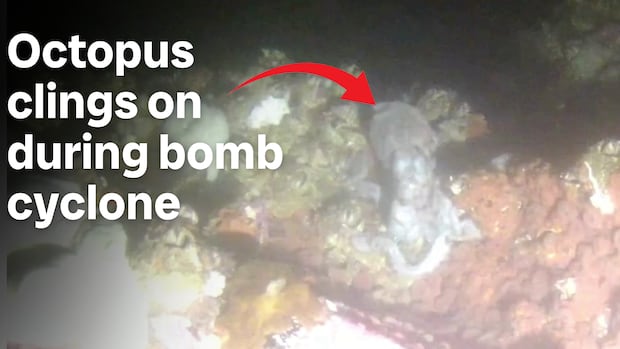Octopus uses all eight legs to cling on during B.C.'s bomb cyclone
Videos taken from sea floor will help researchers understand impact of extreme weather on marine life

Footage captured by ocean researchers offer some insight into how at least one marine animal was affected by the 'bomb cyclone' that hit B.C. this week.
Video shared by Ocean Networks Canada at the University of Victoria shows a giant Pacific octopus as it gets knocked around by a rapidly changing underwater current on the morning of Nov. 20 during a storm that saw gusts of wind as high as 170 km/h.
The footage was captured at Folger Passage near Bamfield on Vancouver Island, where instruments measured waves 10 metres high, compared to the usual one metre, and vertical currents three times stronger than normal.
The video starts with the octopus's legs swirling about as the creature emerges from some shelter and then shows it holding on tight as it shakes around.
But whether it was a positive or negative experience is still open to debate, said Kate Moran, president of Ocean Networks Canada.
"When I first looked at it I thought, 'Wow, this octopus is having a bad day, trying to hold on for dear life,'" she told CBC On the Coast host Gloria Macarenko.
"And then I talked to others on my staff who said 'Oh, maybe the octopus was just trying out this exciting new way the water was moving.' So I think everyone has to look at it themselves to do an interpretation of what was going on."
What is known is just how fast the water was moving: based on readings captured by Ocean Network, the current — which normally moves at a speed of about 60 centimetres a second and only changes very slowly — was going as fast as 200 centimetres a second and then dropping to 15 centimetres a second within four seconds which is why the octopus was getting "whacked around," Moran said.
Parts of the sea floor were ripped off and some of Ocean Network's instruments were knocked offline. It was when a team member was reviewing video to see the conditions that caused the outage that the video of the octopus was found.
Moran said her organization has over 12,000 sensors in Canada's oceans from the Pacific to the Arctic to the Atlantic, but believes this may be the first time her group got to measure the impacts of a bomb cyclone, which is triggered by a rapid drop in atmospheric pressure.
She says they will revisit the site in several weeks to see what, if any, impact there is on marine life.
According to the U.S. government-run National Ocean Service, hurricane-force winds, which generate high waves and rough underwater currents, can negatively impact ecosystems. Higher-than-usual waves result in warmer surface water mixing with colder, saltier water deeper down, sending off fast, rapidly varying currents that can wreak "deadly havoc" on marine life.
"If the wild currents fail to break up coral reefs in their path, the rain-infused water they bring reduces salt levels and otherwise stresses corals. As the hurricane moves toward shore, the underwater tumult can cause shifting sands and muddy shallow waters, blocking the essential sunlight on which corals and other sea creatures rely," the service says.
While this can harm fish and shellfish, Moran said the octopus, as one of the more intelligent and adaptable ocean animals, will likely be fine.
"They're 400 million years old, so they've been around the block," she said.
With files from On the Coast and The Canadian Press



